
EVERY now and then, Hollywood comes up with a good concept, and then competing studios rush to ruthlessly exploit it. Remember the summer of 1998, and dueling asteroid pictures Armageddon and Deep Impact?
Or 1988, the year of the “body switch” movie like Big, Vice Versa and 18 Again?
Or how about 1989? That was the season of underwater horror and sc-fi cinema with Leviathan, Deep Star Six, The Abyss, and Lords of the Deep.
Perhaps nothing nearly so dramatic occurred in the summer of 1997 by comparison. However, two notable, big-budget genre movies — Contact and Event Horizon — were released within approximately one month of each other, and both spotlighted a machine or device that could open a gateway to another place: a distinctly spiritual dimension.
Additionally these devices were conceived in eerily similar visual fashion, as machine-like spheres with spinning outer rings. In other words, the devices resembled high-tech whirligigs.
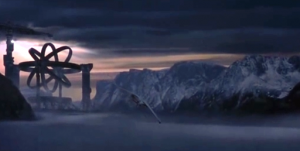
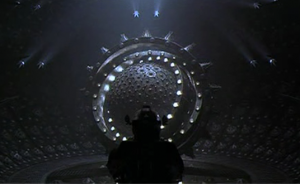
Intriguingly, these 1997 films also complemented one another thematically, functioning as veritable mirror images. The device featured in Contact opened a doorway to a New Age-styled Heaven, and the device in Event Horizon opened to a very Catholic version of Hell.
This was the genre yin-and-yang — the contrary forces — of the summer of 1997.
Contact was a vision of man and his technology connecting to the equivalent of non-denomination bliss, and the opposite view, held in Event Horizon, was of such technology cracking opening a fearsome doorway to torment, guilt, shame, and regret.

“If we are alone, then that’s a whole lot of wasted space out there.”
Based on the novel by Carl Sagan (1934 – 1996), Robert Zemeckis’s Contact depicts the story of a courageous scientist, Ellie Arroway (Jodie Foster) who is obsessed with finding evidence of extra-terrestrial life in the universe, perhaps as a way to honor her dead father (David Morse) whom she misses terribly.
While scouring the Heavens for such life, Ellie detects a signal sent from somewhere near the star, Vega; one that features the “code” for building a miraculous machine that can transport a human astronaut to the stars. The machine is constructed, but destroyed by religious fanatics before Ellie can use it.
Soon, however, Ellie learns of a second such machine, and embarks on a voyage of discovery to a distant and peaceful reality. That dimension is visualized in the film as an endless tropical beach. It is there that Ellie encounters an alien that takes the form of her gentle father, and reminds her, explicitly, that all beings are connected.
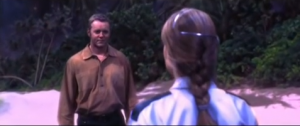
Contact explicitly concerns Ellie’s spiritual journey, and her feelings of isolation from the rest of humanity following her father’s untimely death.
“As zealously as she commits to her scientific belief, Ellis is also continually confronted by the appearance of things spiritual in her life,” writes Brent Marchant in Get the Picture: Conscious Creation Goes to the Movies (Moment Point Press, 2007, page 101).
In other words, there is an acknowledgment in the Zemeckis film that science and old time religion can’t alone answer questions of existence in the modern space age, at least not for the questing Ellie. Her science can’t accept the idea of God, let alone define “meaning” in life. But traditional fire-and-brimstone religion — represented in the film by Jake Busey’s mad and destructive fundamentalist preacher — is too narrow, violent, and judgmental a vehicle to support as well.
By contrast a New Age approach to spiritualism embraces both science and spirituality, while eschewing old borders and dogma. The focus in Contact, instead, is on truly knowing and accepting oneself, and acknowledging that all life, everywhere, is connected.
Ellie’s search for life in outer space can therefore be contextualized as her search to fill the emptiness inside, a spot that was created, perhaps upon the loss of her beloved Dad. Contact thus explores “the religious foundation of modern science’s quest for ultimate answers. No longer are scientists content in dealing with physical phenomenon, but they are now engaged in the metaphysical quest for truth and the ontological cure for loneliness,” suggests Brian Godawa, author of Hollywood World Views: Watching Films with Wisdom and Discernment (InterVarsity Press, 2002, page 165).
Accordingly, Contact visualizes the place of cosmic peace and tranquility (an after-life surrogate, essentially) in grounded, earthly terms, not in the traditional terms one would expect of Heaven. Instead, Ellie finds herself on the shores of that endless tropical beach, with ocean waves ever-lapping gently upon the soft sand. The vision is not one of being close to God, but of spiritual tranquility and inner and outer peace.
The figure that Ellie encounters is also one that fulfills her quest, and ends her emptiness. She is able to see her Dad one last time, and he reminds her that all beings share one universe, and thus bear a responsibility to one another.
“You’re capable of such beautiful dreams and such horrible nightmares,” this alien being tells Ellie about the human race (and herself). “You feel so lost, so cut off, so alone, only you’re not. See, in all our searching, the only thing we’ve found that makes the emptiness bearable is each other.”
Does this alien being refer to the emptiness between the stars — the paucity of intelligent life in the cosmos — or is he referring directly to the emptiness inside people, the emptiness that Ellie has long grappled with and despaired over.
Perhaps he speaks of both.
“In its finest moments, Contact merges spectacle, science, and a genuine religious impulse,” wrote David Denby in New York Magazine (July 21, 1997, page 47), and that is a fine summation of the movie’s unusual alchemy. A woman who believes only in science — and who can’t believe in traditional religious dogma — utilizes a mechanical gateway to find that a non-judgmental, non-fantastical middle-ground exists.
It is a place that science can physically take us, but where the truth and meaning of human existence — connection — is affirmed.
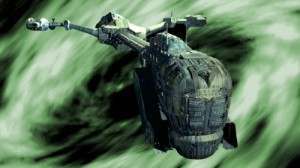
“Hell is only a word. The reality is much worse.”
Event Horizon clearly serves as the yang to Contact’s yin.
In this film from director Paul W.S. Anderson, a small spaceship of the year 2047, the Lewis and Clark, ventures beyond Neptune after receiving a transmission from the Event Horizon, a spaceship that has been missing for seven years.
Aboard Lewis and Clark is Event Horizon’s unstable, cynical creator, Dr.Weir (Sam Neill), who suspects that his experimental faster-than-light drive somehow opened a gateway to another dimension. But as Captain Miller (Laurence Fishburne) and his crew soon learn upon boarding the long-missing vessel, the ship has brought back part of that other dimension — a Hell dimension — with it.
Soon, the Event Horizon — infused with an evil consciousness — begins to manifest elements from Dr. Weir’s, Captain Miller’s and the rest of the crew’s darkest memories. Miller recalls leaving behind a former crew-member, who died in a fire. Weir remembers the suicide of his wife, and his own culpability in her desperation. A third officer, Peters (Kathleen Quinlan) must confront the death of her child.
Like Contact before it, Event Horizon concerns itself with a machine that can transport mankind to another dimension or reality, in this case a place of “pure evil” and “pure chaos.” And also like Contact, Event Horizon doesn’t imagine a God or Devil figure who commands or inhabits that realm. Instead, the film resurrects people from personal memory as the avatars of the “other” dimension.
Ellie encountered her loving father, who reminded her of the importance of connection. Here, Dr.Weir meets the fearsome phantasm of his wife, who killed herself because of him. She thus represents blame…and his guilt. He must relive her suicide, step-by-step, at his creation’s hands, and look at his wife in her dead, scarred state.

In keeping with the concept of guilt, Event Horizon is dominated by Catholic imagery and allusions. The exterior of the malevolent ship — when viewed from the precise right angle — resembles a high-tech crucifix. Worse, if inverted, it could be an upside-down crucifix, suggesting visually the Hellish nature of the thing.
Similarly, several windows inside the ship Event Horizon also resemble a crucifix of sorts. In one memorable composition, a dark figure floats in the air before such a window, his arms outstretched in a Christ-on-the-cross pose. This visual suggests he has been judged and punished for his sins.

And suggesting the liturgy of a Catholic mass, the first message received from Event Horizon upon her return to our universe from Hell, is spoken in Latin. The words are: “liberate tutame ex infernis.”
The translation is literally “Save me from Hell.”
With its Latin warnings of eternal suffering, its crucifix spaceship design, and its enduring obsession on characters’ guilt, Event Horizon suggests that man can never escape from his sins.
On the other hand, Catholic guilt may the very thing that spurs Captain Miller’s heroic sacrifice at the film’s denouement. He dies — he goes to Hell forever — so that members of his crew might live. While burdensome and even crushing to some, Catholic guilt can similarly transform the sufferer into a better, more charitable, and “conscious” person. Catholic guilt reminds the “guilty” that someone paid a price for his or her life, and that said life must therefore be righteous, and honorable.
Described another way, Ellie Arroway goes to the end of the universe in a whirligig machine and finds that she is not alone, that she is connected to other humans, and even to friendly aliens.
Captain Miller and Dr. Weir go to the end of the universe and find that there is a cost for sin: the guilt they carry with them...forever. They can turn that guilt towards madness and suffering, as Weir ultimately does. Or by acknowledging their guilt (and modeling Christ’s death…), they can sacrifice for the good of others.
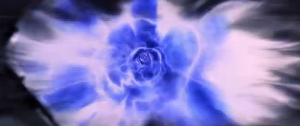
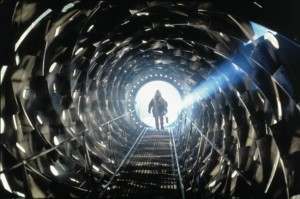
Although Contact and Event Horizon share the concept and design of the whirligig portal, the films serve as mirrors in terms of their spiritual themes, as you can see. Yet they are also mirrors in regards to their visualizations. The portal beyond the whirligig in Contact is light and energetic, a view of dancing rays and beams, connecting Ellie to the faraway beach she ultimately visits.
By contrast, the chamber leading to the whirligig drive or engine in Event Horizon is this dark, labyrinthine tunnel, one where byzantine spikes poke out of every wall.
If Contact is about one person’s energy connecting with another’s so that the universe has meaning for all of us, Event Horizon is about a “Gothic emanation of the abyss,” according to The Cambridge Companion to Gothic Fiction (Cambridge University Press, 2007, page 297). Anderson’s film says that even if the universe is Hell, our pain, our guilt, can be used to help our fellow man.
Not surprisingly, many movie critics of 1997 praised the sci-fi film, Contact, while just as many derided the more horrific Event Horizon. This response is ironic, given the two films’ abundant similarities in narrative and thematic terrain.
In retrospect, perhaps, we can detect that these two movies are even better when considered in tandem, and as the yin and yang of human spirituality on the cusp of the 21st century.
Would you like to support Flashbak?
Please consider making a donation to our site. We don't want to rely on ads to bring you the best of visual culture. You can also support us by signing up to our Mailing List. And you can also follow us on Facebook, Instagram and Twitter. For great art and culture delivered to your door, visit our shop.

